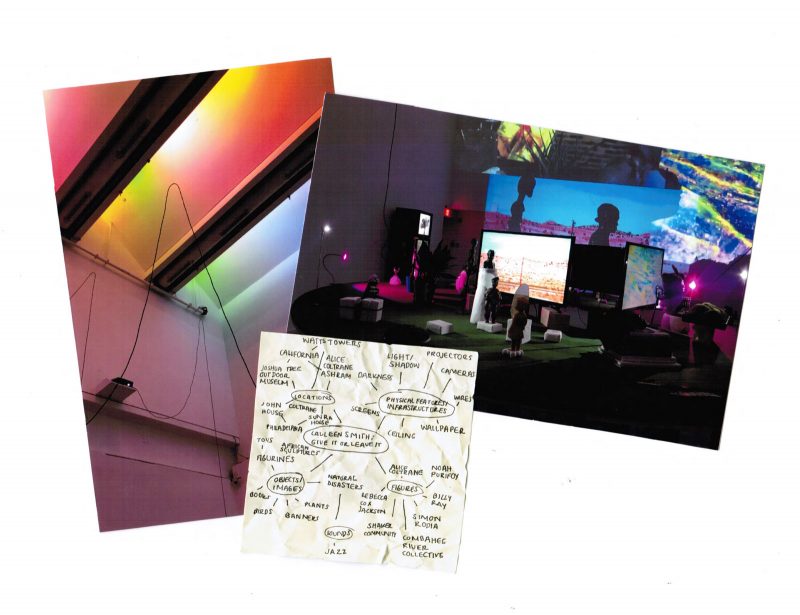The Universe of Cauleen Smith, Cauleen Smith: Give It or Leave It, Institute of Contemporary Art, Philadelphia
By Emma C. Roberts
A “universe” is a set that contains all elements relevant to a particular discussion, but it is also defined as the entirety of space and its contents. It is something based in logic, but also something that cannot be summarized in bullet points. Cauleen Smith: Give It or Leave It is a universe in both senses of the word, it contains components that can be described as parts of the exhibition’s whole, but the concepts, figures, and images woven throughout the galleries at the Institute of Contemporary Art are nearly impossible to map, and I tried.

Above is a rough web of ideas I laid out during my first couple of visits to the exhibition while preparing to write this. I noted recurring historical figures, images, sounds, locations, as well as the physical features of the gallery spaces and the digital infrastructures that fill them. When charting these things, I realized that no size of paper could accurately represent the web that Smith weaves in Give It or Leave It. And furthermore, no installation photograph could touch the surface of these ideas. For Smith creates a world within the three-gallery exhibition that is incredibly difficult to break down and explain with a simply defined set of elements.
The historical figures noted above are united by their personal seclusion in the process of building improved, though at times withdrawn, worlds. Simon Rodia, an Italian immigrant, spent 33 years building the 17 structures that make up Watts Towers in the neighborhood of Watts, Los Angeles. Alice Coltrane, a successful American jazz musician, abandoned a secular life to establish what is now called the Sai Anantam Ashram, leaving public performance for 25 years. Noah Purifoy spent 15 years constructing his Outdoor Desert Art Museum in Joshua Tree. And Rebecca Cox Jackson established the first black Shaker community for women in Philadelphia. Looking at these individuals and the physical and ideological spaces they developed, it becomes evident that just as Rodia, Purifoy, Coltrane, or Jackson imagined different worlds, Smith’s exhibition itself becomes a site of otherworldly speculation. This is especially notable in the center room of the exhibition. The works in this gallery collide without clear boundaries. Each minute or monumental feature of the room, from the small objects on the table to the luminescent wallpaper to the scattered lawn chairs, all become points of light in a conceptual cosmos. There are complex relationships between all of these elements, but separating and defining these seemed somewhat superfluous when in the space. This is underlined by the lack of clear definitions between individual works. Experiencing the world that Smith built within the gallery is much more significant than establishing distinctions.
The digital infrastructures that support the works in this gallery, the cameras, projectors, and wires, serve both practical and sculptural purposes. The wires drape down from the ceiling, swooping in vine-like forms that are reminiscent of Eva Hesse’s “Untitled (Rope Piece).” Meanwhile, the cameras that circle the table of closed-circuit tableaux vivants stand side-by- stand with human visitors, making the table a site of spectatorship. The eye of the camera is just as subjective as the eyes of the human viewer, cutting some of the objects out of the camera’s frame completely and blowing the small landscapes into what appear as uncontrollable natural disasters on the wall. Just as the human viewer does, the camera gazes on the landscapes in real time. The stream of video that the cameras create is not historicized, like much of Smith’s subject matter, it lives in the present.
Making historicized images contemporary is a recurrent theme throughout Give It or Leave It. In Sojourner, Smith reinvents 1966 LIFE magazine photographs by Billy Ray, recasting the group of stylish young men for women and shifting the setting from Watts Towers to Noah Purifoy’s outdoor museum. In Pilgrim, she momentarily inserts archival footage of Watts Towers amongst recent footage of Alice Coltrane’s Ashram. While the archival footage is clearly historical, the quiet emptiness of the ashram in the present day underlines the energy it maintains from its vibrant past. This is also evident in contemporary footage of the Philadelphia homes of John Coltrane and Sun Ra Arkestra respectively. Each work across the exhibition charts a relationship between location and time. The recurrence of locations across individual works in the exhibition makes it difficult to recall the works as distinct entities, but instead components in a universe of Smith’s creation.
Throughout Give It or Leave It, Smith moves across chronology and geography, establishing the continued need for dynamic, reimagined worlds. By borrowing from history, Smith herself constructs a universe by questioning our present moment. She encourages us to not take comfort in logic. I discovered in my struggle to fully define the components of Smith’s exhibition that a universe cannot and should not be static or easily defined.
Emma C. Roberts is a curator and art writer based in Philadelphia. She has worked on curatorial projects at the Solomon R. Guggenheim Museum, the Smithsonian American Art Museum, and Temple Contemporary. She is interested in artistic and curatorial interventions that yield unexpected results.









